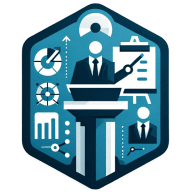How to Stay Resilient and Adaptable in a Changing Workplace
In a rapidly evolving professional landscape, the ability to pivot and persevere is invaluable. This article distills expert advice on nurturing resilience and adaptability, offering actionable strategies for thriving amidst workplace change. Discover the transformative power of mental agility, problem solving, and a forward-thinking approach to setbacks.
- Practice Mental Fitness Techniques
- Focus on Problem Solving
- Maintain a Growth Mindset
- Prioritize Adaptability Over Perfection
- Reframe Setbacks as Data Points
- Embrace a Flexible Mindset
Practice Mental Fitness Techniques
Staying resilient and adaptable in a changing work environment is imperative for impactful leadership, productivity, and well-being. Practicing mental fitness techniques is a great way to manage stress and overwhelm due to ongoing change in the workplace. When we're mentally fit, we're able to handle life's challenges with a positive versus a negative mindset.
Mental fitness techniques involve engaging the senses in a series of short micro-meditations. Examples include:
* Counting to three, breathing in slowly through your nose, and exhaling slowly to a count of three.
* Focusing intently on something you can see, noticing tiny details, such as colors, shapes, and textures.
* Listening intently to the various sounds within your environment. Notice the most distant sound, then shift focus to the closest sound that you can hear, which is often the sound of your breath.
* Rubbing two fingertips slowly together, noticing the fingertip ridges, the temperature of your fingertips, and the texture (are they dry or smooth).
Each short micro-meditation takes between 10-15 seconds to complete.

Focus on Problem Solving
Resilience in the tree care industry comes down to adaptability and a deep understanding of the work, which I've developed over more than 20 years in the field. One mindset that has helped me navigate uncertainty is focusing on problem solving rather than obstacles. For example, during the 2021 winter storm in Texas, we faced an overwhelming number of emergency calls due to fallen trees and property damage. With power outages and road closures, we had to quickly reorganize operations, prioritize the most urgent cases, and ensure our team's safety while working in extreme conditions. My certification as an arborist and my experience in risk assessment allowed me to make critical decisions about which trees posed the greatest hazards and how to remove them safely without causing further damage. By maintaining clear communication with customers and adjusting our workflow daily, we managed to help dozens of homeowners while keeping our team efficient and safe.
The key to staying adaptable is combining experience with a willingness to learn and adjust quickly. Over the years, I've learned that no two jobs are the same, and being open to new techniques and technologies in the industry has been essential. When challenges arise, I remind myself that every problem has a solution and that staying calm and proactive leads to better outcomes. Whether it's a severe weather event, a shift in regulations, or new customer expectations, embracing change with a strategic mindset has helped me and my team continue to grow.

Maintain a Growth Mindset
Resilience and adaptability in the workplace come down to maintaining a growth mindset and being proactive rather than reactive. With over 30 years of experience in physical therapy, I've seen the industry evolve significantly from advancements in treatment methods to the rise of technology in healthcare. One of the key coping mechanisms that has helped me navigate uncertainty is staying curious and committed to lifelong learning. Whether it's integrating new rehabilitation techniques, adjusting to the rise of telehealth, or responding to the changing needs of patients due to more sedentary work environments, I make it a priority to embrace change rather than resist it. This mindset was crucial when I transitioned from running Collins Place Physio to launching The Alignment Studio. I saw a growing need for an integrated health and wellness approach, and instead of sticking with the status quo, I took a leap and created a multidisciplinary clinic that combined physical therapy, Pilates, remedial massage, podiatry, and nutrition, all under one roof.
A great example of adaptability in action was during the COVID-19 pandemic when we had to quickly shift our operations to support patients remotely. With lockdowns in place, in-person appointments became impossible, and many patients were struggling with pain and mobility issues while working from home in non-ergonomic setups. Drawing on my experience and qualifications, I led our team in rapidly implementing telehealth consultations, guiding patients through home exercise programs, and providing virtual posture assessments. This allowed us to continue delivering high-quality care despite the challenges. More importantly, it reinforced the value of flexibility in healthcare, showing that even in a hands-on profession like physical therapy, we could still make a meaningful impact through innovation and adaptability. That experience not only strengthened our clinic's resilience but also paved the way for long-term changes in how we deliver care, ensuring that we stay ahead of the curve in an ever-evolving industry.

Prioritize Adaptability Over Perfection
One mindset that has helped me stay resilient is focusing on adaptability over perfection. Instead of resisting change, I see it as an opportunity to improve. When faced with uncertainty, I prioritize learning and iteration, treating challenges as experiments rather than obstacles.
A key coping mechanism I use is scenario planning—anticipating different possible outcomes and having flexible strategies for each. This reduces stress because I'm not reacting impulsively but adjusting based on well-thought-out possibilities.
I also make it a habit to seek diverse perspectives, whether from my team, mentors, or industry peers. This helps me see change from different angles and spot opportunities others might miss.
Lastly, I practice mental agility by focusing on what I can control—my response, mindset, and ability to pivot. Instead of fearing change, I embrace it as a constant, knowing that adaptability is the key to long-term success.

Reframe Setbacks as Data Points
I stay resilient by reframing each setback as a data point rather than a failure. Specifically, I carve out "debrief and dissect" time after a project hits a snag, using a structured outline to pinpoint precisely what went wrong and why—like running a mini post-mortem. Once I've documented the issues, I highlight one or two key lessons I can apply immediately to the next iteration. This shifts my mentality from feeling stuck or discouraged to viewing setbacks as essential checkpoints in the larger development process. A clear, repeatable system for evaluating and learning from bumps in the road keeps me focused on the bigger picture and helps maintain a positive, forward-looking mindset.

Embrace a Flexible Mindset
Picture this: You're halfway through a pivotal project when the client calls for a sudden, drastic pivot in strategy. It's a freelancer's all-too-familiar tale, yet navigating this fluidly is what distinguishes the proficient from the inexperienced. Embracing a flexible mindset is crucial. Think of it like being a jazz musician; improvisation becomes your best tool.
First, cultivate a clear, ongoing communication channel with your client. This not only helps in understanding their needs and expectations but also positions you as a proactive partner rather than just a service provider. When changes arise, discuss them thoroughly to understand the new direction and the reasons behind it. This dialogue often unveils insights into the client’s strategic thinking and can guide your adaptive measures effectively.
Second, maintain a modular approach to your work. Break down your projects into phases or segments that can be easily adjusted or swapped without disrupting the entire operation. This structural flexibility can save you immense time and reduce frustration when course corrections are needed.
Lastly, always factor in contingency time and resources when planning your projects. This buffer can be a lifesaver when unexpected changes occur. By preparing for the possibility of change, you can ensure that these shifts do not throw your schedule into chaos. This triad of communication, modular structure, and preparedness fosters not only adaptability but also a reputation for reliability and resilience, qualities that are invaluable in the freelancing world.


